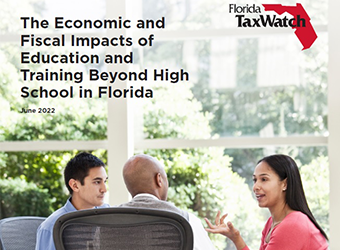 In 2019, Florida aimed for 60 percent of working-age Floridians to hold a workforce specialization, whether from a certificate, credential, training, or degree with the SAIL to 60 Initiative. Currently, Florida has yet to reach this goal, falling 791,000 people short, and its individual populations are working toward the goal at incomparable rates.
In 2019, Florida aimed for 60 percent of working-age Floridians to hold a workforce specialization, whether from a certificate, credential, training, or degree with the SAIL to 60 Initiative. Currently, Florida has yet to reach this goal, falling 791,000 people short, and its individual populations are working toward the goal at incomparable rates.
In January 2022, Florida TaxWatch released “The Economic and Fiscal Impacts of Education and Training Beyond High School in Florida,” which was sponsored by FCAN and identified current education achievement gaps and how these gaps impact Florida’s economy. This initial briefing reported that:
- Compared to other demographic groups, Asian and White adults have the greatest proportion of postsecondary degrees;
- The percentages of Hispanic and Black populations earning a bachelor’s degree or higher are significantly lower compared to other demographic groups;
- The percentages of White, Black, and Hispanic females with an associate degree or higher are eight to ten percentage points greater than their male counterparts; and
- While postsecondary training is an important type of specialization, their inclusion in the aforementioned calculations would not have revealed more comparable achievement among the different demographic groups.
In this culminating report, Florida TaxWatch includes previous findings but also considers what is needed to reach the 60 percent target; further examines the economic, fiscal, and societal benefits of education and training beyond high school; and recommends considerations for policymakers.
Visit FCAN’s “Research & Data” section to learn more and download the brief.
RELATED ARTICLES:
Part 1 of The Economic and Fiscal Benefits of Education and Training Beyond High School in Florida
Learn more about Talent Strong Florida
